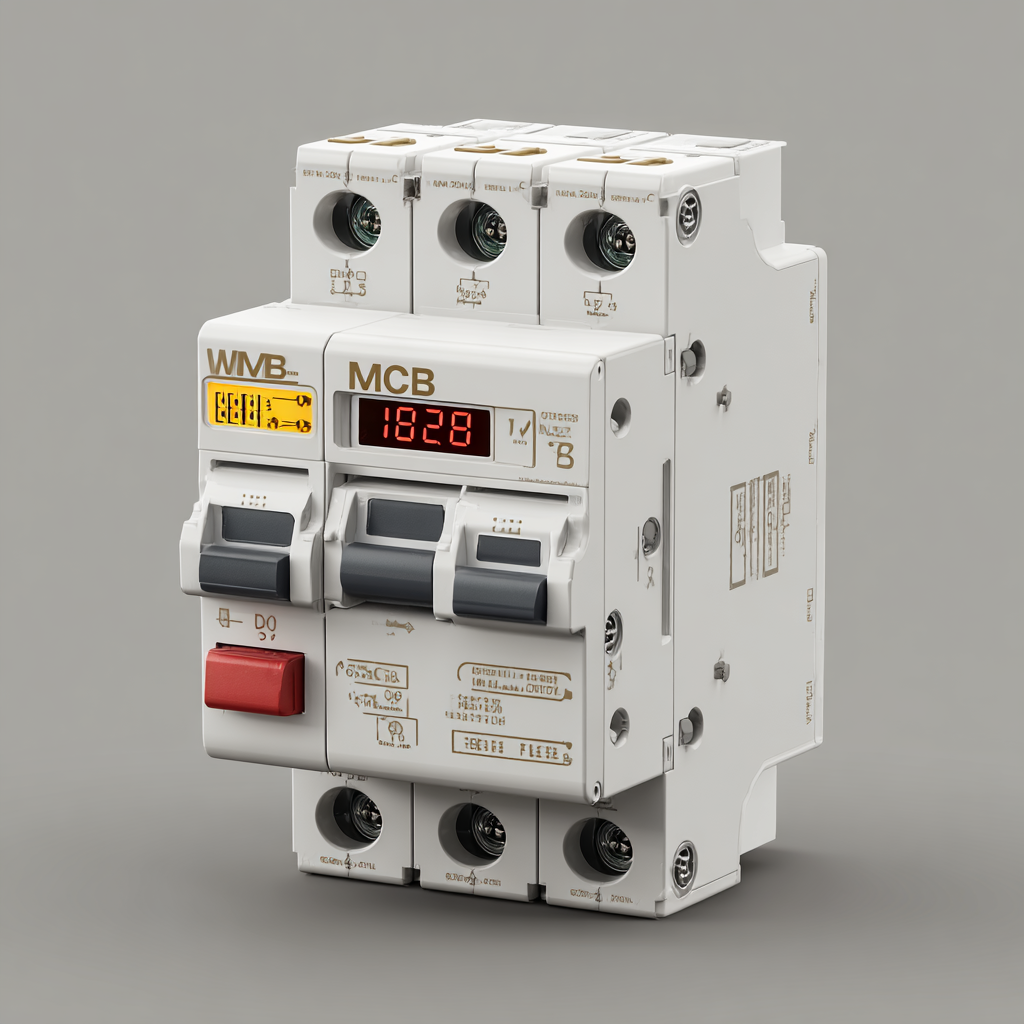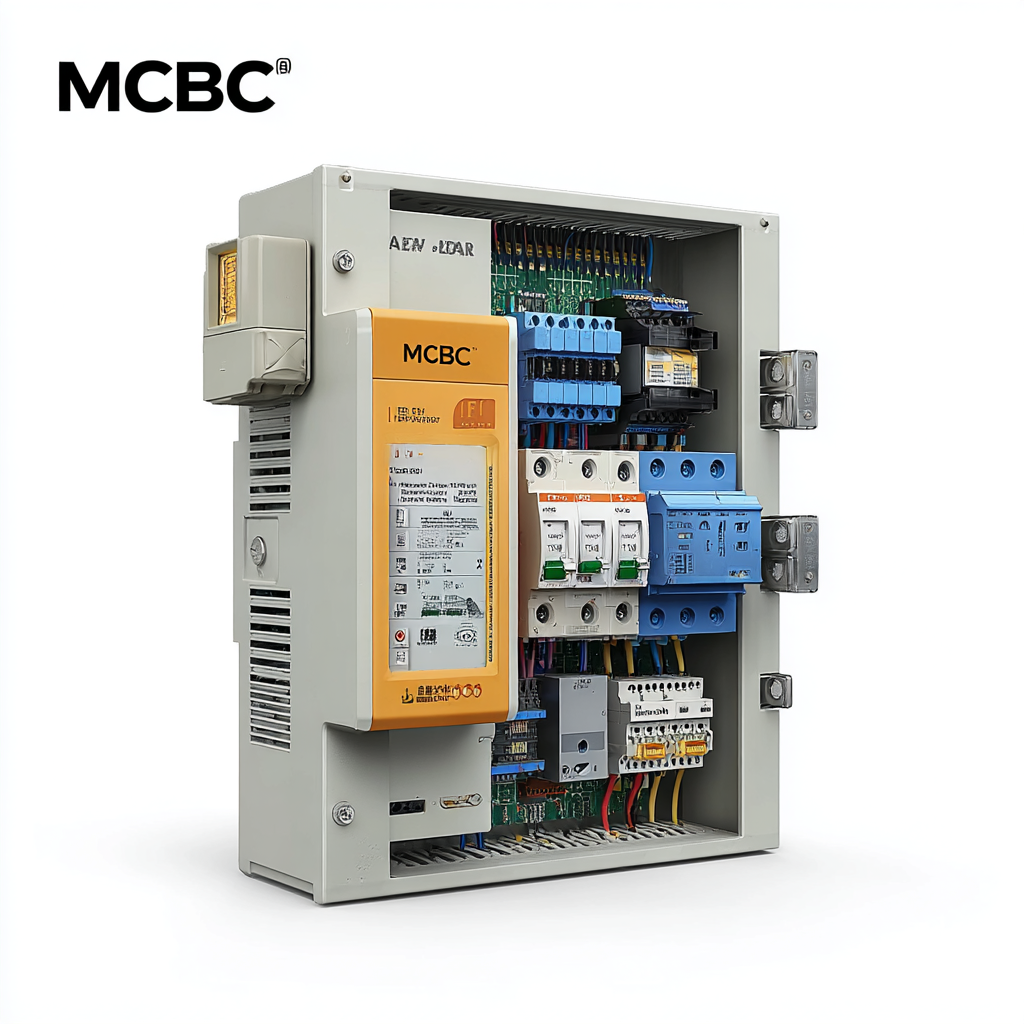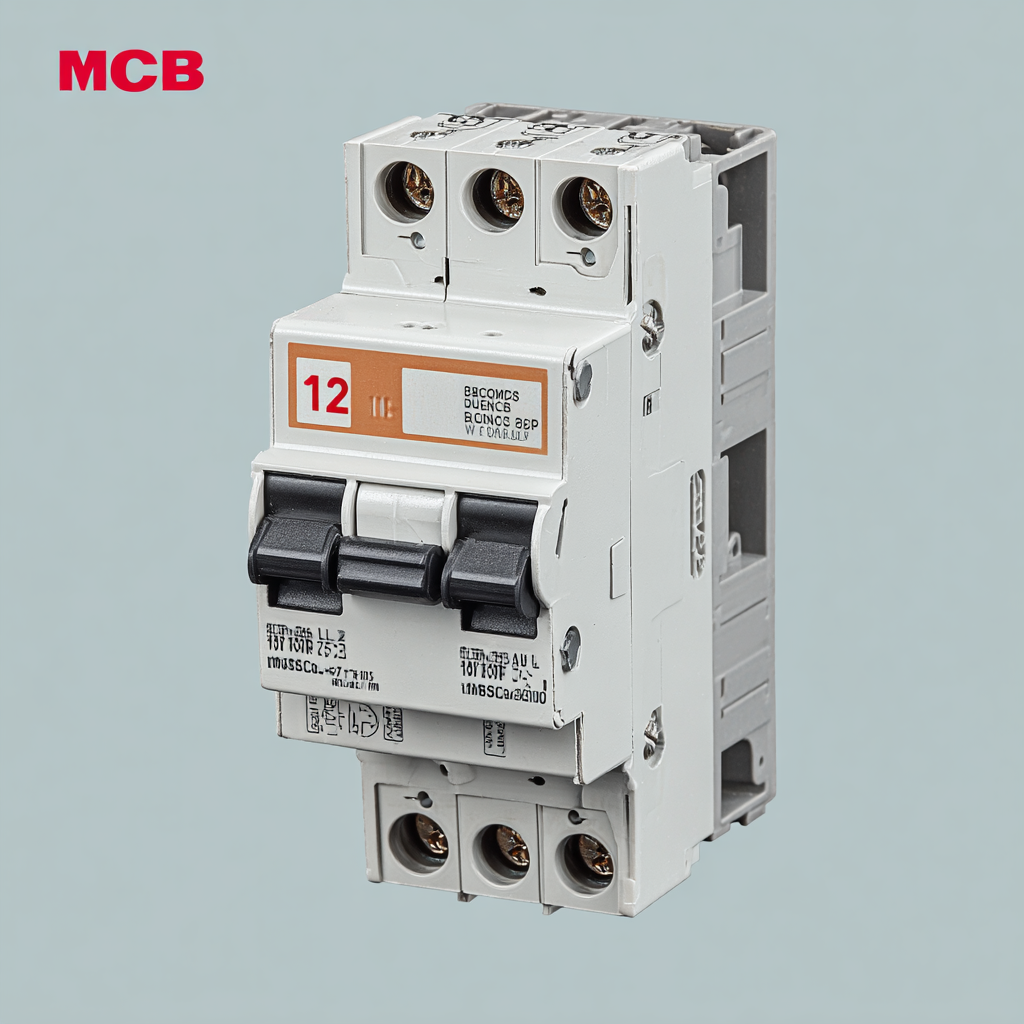
12 Reasons Why Best Electronic MCCB Should Be Your Top Choice
In recent years, the demand for Electronic MCCB (Molded Case Circuit Breakers) has surged, underscoring their essential role in modern electrical systems. According to a report by MarketsandMarkets, the global market for MCCBs is projected to reach USD 7.52 billion by 2026, growing at a CAGR of 5.5% from 2021 to 2026. This growth is driven by the increasing need for energy-efficient solutions and the rising adoption of automation in industries. Electronic MCCBs offer advanced features such as intelligent monitoring, precise overload protection, and enhanced operational efficiency, which make them superior to traditional MCCBs. With their versatility and high performance, Electronic MCCBs are becoming the top choice for various applications, from residential buildings to large industrial complexes. This blog will explore 12 compelling reasons why Electronic MCCBs should be integrated into your electrical systems, highlighting their distinct characteristics and appropriate use cases.

Advantages of Using Electronic MCCBs Over Traditional Circuit Breakers
When it comes to safeguarding electrical systems, the choice between electronic MCCBs (molded case circuit breakers) and traditional circuit breakers is pivotal. One of the major advantages of electronic MCCBs is their advanced monitoring capabilities. They can provide real-time data on current load, voltage fluctuations, and potential fault conditions, which enables proactive maintenance and minimizes downtime. This sophisticated intelligence allows for quicker fault detection, ensuring that issues can be resolved before they escalate into significant problems.
Another significant benefit of electronic MCCBs is their customizable protection settings. Unlike traditional circuit breakers, which often come with preset trip times and ratings, electronic MCCBs offer the flexibility to tailor settings based on specific application requirements. This adaptability not only enhances the safety of electrical systems but also contributes to energy efficiency by preventing unnecessary tripping due to momentary overloads. Furthermore, the compact design of electronic MCCBs makes them suitable for various installations, allowing for easier integration into existing electrical infrastructures without taking up excessive space.
Key Performance Metrics: Analyzing the Efficiency of Electronic MCCBs
When considering the efficiency of electronic molded case circuit breakers (MCCBs), it is crucial to analyze key performance metrics that define their effectiveness. Electronic MCCBs are known for their modularity and flexibility, which allow for tailored configurations to meet specific safety and operational needs. This adaptability not only enhances performance but also ensures compliance with modern safety standards.
To maximize the benefits of electronic MCCBs, it’s advisable to perform regular diagnostics. Monitoring current and voltage levels can help detect anomalies early, which may prevent costly downtime and equipment damage. Additionally, understanding the specific load requirements of your system is essential; this ensures that the MCCBs you choose are appropriately rated and can handle fluctuations in demand.
Another vital tip is to invest in MCCBs that offer advanced protection features, such as ground fault and overload protection. These features not only safeguard your electrical systems but also contribute to energy efficiency by minimizing unnecessary energy consumption. Ultimately, selecting the right electronic MCCB can lead to improved operational efficiencies and enhanced safety in any digital-driven environment.
Cost Comparison: Long-term Savings with Electronic MCCBs
When considering electrical systems, the choice between traditional molded case circuit breakers (MCCBs) and electronic MCCBs can significantly impact your long-term operational costs. Although electronic MCCBs may seem more expensive upfront, their advanced features lead to substantial savings over time. They provide precise protection and can easily adapt to varying load conditions, reducing the risk of damaging overloads and minimizing downtime. This adaptability not only enhances the safety of your electrical systems but can also reduce repair and maintenance costs in the long run.

Moreover, electronic MCCBs typically offer real-time monitoring capabilities, allowing businesses to analyze energy consumption patterns and detect inefficiencies. This data-driven approach enables companies to make informed decisions about energy management, ultimately leading to reduced electricity bills and optimized operations. With ongoing advancements in technology, the enhanced performance and functionality of electronic MCCBs become evident, reinforcing their cost-effectiveness as a strategic investment in the long run. Transitioning to electronic MCCBs means embracing both safety and efficiency, making them an obvious choice for savvy business operators.
Enhancements in Safety Features: Why Electronic MCCBs Lead the Industry
With the advancement of technology, electronic MCCBs (Molded Case Circuit Breakers) have become the industry standard for ensuring safety in electrical systems. One of the primary enhancements in safety features is the integration of smart technology, which allows for real-time monitoring and diagnostics. This enables operators to quickly identify potential issues before they escalate, significantly reducing the risk of electrical failures and enhancing overall system reliability.
Another critical aspect of electronic MCCBs is their ability to provide precise protection settings. Unlike traditional thermal magnetic breakers, electronic MCCBs can be customized to respond to various fault conditions, ensuring that the system is safeguarded against overloads and short circuits. This feature not only improves safety but also allows for better performance efficiency, making them an indispensable choice for modern electrical installations.
**Tips:** When selecting an electronic MCCB, consider models with advanced communication capabilities. This can facilitate remote monitoring and seamless integration into building management systems. Additionally, always opt for devices that align with the latest safety standards to ensure compliance and long-term reliability in operation.
12 Reasons Why Best Electronic MCCB Should Be Your Top Choice - Enhancements in Safety Features: Why Electronic MCCBs Lead the Industry
| Feature | Description | Benefits |
|---|---|---|
| Advanced Protection | Integrates various protection functions including overload, short circuit, and earth fault protection. | Minimizes risk of equipment damage and increases system reliability. |
| Smart Features | Monitors electrical parameters and provides real-time data. | Enhances decision-making and predictive maintenance capabilities. |
| Compact Design | Saves space while offering high performance. | Ideal for installations with limited space while maintaining high functionality. |
| User-Friendly Interface | Digital displays and intuitive controls. | Simplifies operation and reduces training time for users. |
| Environmentally Friendly | Reduced energy consumption and elimination of harmful materials. | Supports sustainability objectives and regulatory compliance. |
| Enhanced Tripping Mechanism | Automatic and adjustable trip settings. | Optimizes protection based on specific application requirements. |
| Remote Monitoring | Allows for off-site access to performance data. | Improves operational oversight and response times. |
| Customizable Settings | Flexibility in configuring parameters to suit applications. | Allows for tailored solutions that enhance system efficiency. |
| Lower Maintenance Costs | Durable design with fewer mechanical parts. | Reduces overall maintenance needs and costs over time. |
| Compliance with Standards | Meets international safety and performance standards. | Ensures reliability and reduces liability for manufacturers. |
| Support for Future Upgrades | Compatibility with future technologies. | Extends lifecycle and improves ROI on installations. |
Environmental Impact: The Sustainability of Electronic MCCBs in Modern Systems
In the quest for sustainability within modern electrical systems, Electronic Molded Case Circuit Breakers (MCCBs) are quickly becoming the preferred choice. One of the primary reasons is their ability to minimize operational inefficiencies often seen in traditional circuit breakers. Recent advancements in sensor technology have demonstrated that electronic MCCBs can significantly reduce both operational and standby power losses. According to industry reports, deploying advanced predictive maintenance tools can lower energy wastage by up to 20%, aligning with global energy efficiency goals.

Moreover, electronic MCCBs offer unparalleled connectivity through cloud-based solutions, enabling real-time data analysis and remote energy management. This connectivity not only enhances operational monitoring but also fosters proactive decision-making regarding energy consumption. Industry statistics suggest that companies implementing such smart technologies can expect a return on investment through energy savings of 10-15% annually. These innovations not only contribute to the sustainability of electrical systems but also align with a broader commitment to reducing carbon footprints, demonstrating the vital role of electronic MCCBs in the modern energy landscape.

 JCB1-125
JCB1-125 JCB2-40M
JCB2-40M JCB3-63DC
JCB3-63DC JCB3-80H
JCB3-80H JCB3-80M
JCB3-80M JCBH-125
JCBH-125 JC125-4P
JC125-4P JCMX
JCMX JCSD
JCSD JCOF
JCOF JCMX1-125
JCMX1-125 JCOF1-125
JCOF1-125 JCSD1-125
JCSD1-125 JCR3HM
JCR3HM JCRD2-125
JCRD2-125 JCRD4-125
JCRD4-125 JCRB2-100
JCRB2-100 JC3RH-2P
JC3RH-2P JC3RH-S
JC3RH-S JC3RH-B
JC3RH-B JC3RH-BS
JC3RH-BS JCR2-63
JCR2-63 JCR1-40
JCR1-40 JCB2LE-80M
JCB2LE-80M JCB2LE-80M
JCB2LE-80M JCB2LE-80M
JCB2LE-80M JCB2LE-40M
JCB2LE-40M JCB1LE-125
JCB1LE-125 JCB3LM-80
JCB3LM-80 JCH2-125
JCH2-125 JCH2-125
JCH2-125 CJX2
CJX2 CJ19
CJ19 JCMCU
JCMCU JCHA
JCHA JCSD-40
JCSD-40 JCSD-60
JCSD-60 JCSP-40
JCSP-40 JCSP-60
JCSP-60 JCSPV
JCSPV WEW1-1000
WEW1-1000 WEW1-1600
WEW1-1600 WEW1-2000
WEW1-2000 WEW1-3200
WEW1-3200 WEW1-4000
WEW1-4000 WEW1-6300
WEW1-6300 DC6-125
DC6-125 AX-400-1250
AX-400-1250 AXAL-400-1250A
AXAL-400-1250A AL-400-1250
AL-400-1250 DC3-160
DC3-160 AXS-400-1250A
AXS-400-1250A SHT-125-160
SHT-125-160 UVT-125-160A
UVT-125-160A P-250A-3P-A
P-250A-3P-A 400-3P/4P terminal cover
400-3P/4P terminal cover 1250-3Pmccb accessories busbar
1250-3Pmccb accessories busbar 250-3P terminal conver
250-3P terminal conver WLM6-TCV-160A-3P
WLM6-TCV-160A-3P WLM6-MIP-250A
WLM6-MIP-250A WLM6-125A-3300 3P/4P
WLM6-125A-3300 3P/4P WLM6-160A-3300 3P/4P
WLM6-160A-3300 3P/4P WLM6-250A-3300 3P/4P
WLM6-250A-3300 3P/4P WLM6-400A-3300 3P/4P
WLM6-400A-3300 3P/4P WLM6-630A-3300 3P/4P
WLM6-630A-3300 3P/4P WLM6-800A-3300 3P/4P
WLM6-800A-3300 3P/4P WLM6-1250A-3300 3P/4P
WLM6-1250A-3300 3P/4P WLM6-1600A-3300 3P/4P
WLM6-1600A-3300 3P/4P WLM6-2000A 3P/4P
WLM6-2000A 3P/4P WLM8-125H-3300
WLM8-125H-3300 WLM8-250H-3300
WLM8-250H-3300 WLM8-400H-3300
WLM8-400H-3300 WLM8-400H-4300
WLM8-400H-4300 WLM8-630H-3300
WLM8-630H-3300 WLM8-630H-4300
WLM8-630H-4300 WLM6RT-125A
WLM6RT-125A WLM6RT-160A
WLM6RT-160A WLM6RT-250A
WLM6RT-250A WLM6RT-400A
WLM6RT-400A WLM6RT-630A
WLM6RT-630A WLM6RT-800A
WLM6RT-800A WLM6RT-1250A
WLM6RT-1250A WLM6E-160A-3300 3P
WLM6E-160A-3300 3P WLM6E-250A-3300
WLM6E-250A-3300 WLM6E-400A-3300 3P/4P
WLM6E-400A-3300 3P/4P WLM6E-630A-3300
WLM6E-630A-3300 WLM6E-800A-3300 3P/4P
WLM6E-800A-3300 3P/4P WLM6E-1250A-3300
WLM6E-1250A-3300 WLM6E-1600-3300 3P/4P
WLM6E-1600-3300 3P/4P WLM6E-2000A-3300 3P/4P
WLM6E-2000A-3300 3P/4P WLM8E-250H-3300
WLM8E-250H-3300 WLM8E-400H-3300
WLM8E-400H-3300 WLM8E-400H-4300
WLM8E-400H-4300 WLM8E-630H-3300
WLM8E-630H-3300 WLM8E-630H-4300
WLM8E-630H-4300 WLM6EY-250-3300 3P/4P
WLM6EY-250-3300 3P/4P WLM6EY-400 3P/4P
WLM6EY-400 3P/4P WLM6EY-630 3P/4P
WLM6EY-630 3P/4P WLM6EY-800A 3P/4P
WLM6EY-800A 3P/4P WLM6EY-1250A 3P/4P
WLM6EY-1250A 3P/4P WLM6ELY-160A
WLM6ELY-160A WLM6ELY-250A
WLM6ELY-250A WLM6ELY-400A
WLM6ELY-400A WLM6ELY-800A
WLM6ELY-800A WLM6ELY-1250A
WLM6ELY-1250A WLM8EY-250H-3300
WLM8EY-250H-3300 WLM8EY-400H-3300
WLM8EY-400H-3300 WLM8EY-630H-3300
WLM8EY-630H-3300 WLM6LY-125A
WLM6LY-125A WLM6L-160A
WLM6L-160A WLM6LY-250A
WLM6LY-250A WLM6LY-400A
WLM6LY-400A WLM6LY-800A
WLM6LY-800A WLM6LY-630A
WLM6LY-630A WLM6LY-1250A
WLM6LY-1250A WLM8LY-125H-3300
WLM8LY-125H-3300 WLM8LY-250H-3300
WLM8LY-250H-3300 WLM8LY-400H-3300
WLM8LY-400H-3300 WLM8LY-630H-3300
WLM8LY-630H-3300 JCB3-63DC
JCB3-63DC JCB1-125DC
JCB1-125DC WLM7DC-250A-2300 2P/3P
WLM7DC-250A-2300 2P/3P WLM7DC-315A-3300 2P/3P
WLM7DC-315A-3300 2P/3P WLM7DC-400A-2300 2P/3P
WLM7DC-400A-2300 2P/3P WLM7DC-630A-3300 3P
WLM7DC-630A-3300 3P WLM7DC-800A-2300 2P/3P
WLM7DC-800A-2300 2P/3P WLM7DC-400A 2300
WLM7DC-400A 2300 WLM7DC-630A-2300 2P
WLM7DC-630A-2300 2P WLM7HU-250-3300 3P
WLM7HU-250-3300 3P WLM7HU-315-3300 3P
WLM7HU-315-3300 3P WLM7HU-400-3300 3P
WLM7HU-400-3300 3P WLM7HU-630-3300 3P
WLM7HU-630-3300 3P WLM7HU-800-3300 3P
WLM7HU-800-3300 3P PV-1500V/250A
PV-1500V/250A WEW3-1600
WEW3-1600 WEW3-2500
WEW3-2500 WEW3-4000
WEW3-4000 WEW3-7500
WEW3-7500



